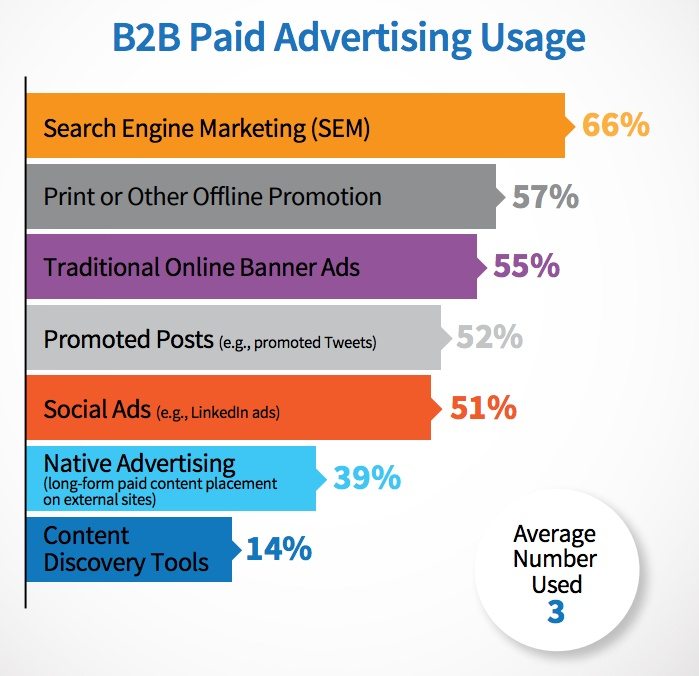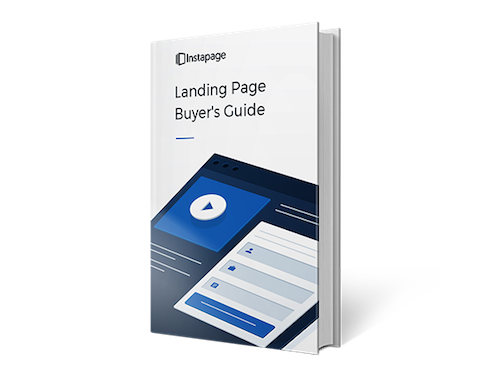What separates best-in-class marketers from all others? Is it talent? Work ethic? Maybe creativity? Or the way they use technology like marketing software?
We can speculate on all three, but we’re sure about at least one thing they do differently than the rest:
Adopt technology.
A report from the Aberdeen Group, titled “The State of Marketing Technology 2016: Controlling the Chaos,” reveals that popular marketing software is more widely used by best-in-class marketers than all others:
- CRM: Best-in-class: 76%, All others: 76%
- Video conferencing solution: Best-in-class: 67%, All others: 59%
- Email service provider: Best-in-class: 64%, All others: 61%
- Marketing automation platform: Best-in-class: 58%, All others: 50%
- Print materials & solutions: Best-in-class: 52%, All others: 50%
- Data visualization solutions: Best-in-class: 52%, All others: 33%
- CMS: Best-in-class: 52%, All others: 51%
The same can be said about fringe and emerging technologies, except in the case of SEO solutions.
- Post-click landing page software or optimization platform: Best-in-class: 45%, All others: 32%
- Content marketing platform: Best-in-class: 45%, All others: 30%
- Visual editing/design tools: Best-in-class: 42%, All others: 38%
- SEO services & solutions: Best-in-class: 42%, All others: 47%
- Social listening/analytics solution: Best-in-class: 42%, All others: 22%
- Event marketing/management solution: Best-in-class: 42%, All others: 21%
- Contact data/business intelligence solution: Best-in-class: 33%, All others: 27%
- Banner/display ad solution: Best-in-class: 33%, All others: 29%
- Project management technology: Best-in-class: 33%, All others: 26%
- Retargeting ad solution: Best-in-class: 30%, All others: 19%
In total, data shows that best-in-class marketers rely on an average of 7 technologies, mostly integrated to form an effective marketing stack.
- A collection of specialized but unconnected solutions: Best-in-class: 13%, All others: 34%
- A collection of specialized solutions with some integrations: Best-in-class: 33%, All others: 34%
- A mostly integrated system of complementary solutions: Best-in-class: 40%, All others: 23%
- A highly integrated system or “cloud” of complementary solutions: Best-in-class: 14%, All others: 9%
“But guys,” you might say, “that’s because top marketers have deeper pockets. With more money to spend, it’s not surprising they out-adopt smaller teams with lower budgets.”
That’s not a bad guess, but Aberdeen’s Andrew Moravick says it’s untrue. Nearly 85% of best-in-class marketers belong to companies earning less than $50 million annually.
Instead, he claims, it’s “rather because these savvy marketers are much more effective in identifying the right technology tools they need and excel in using them effectively.”
For those of us who aren’t industry leaders, that’s not easy to do. If you’re part of a team trying to find the right marketing software to accomplish your business’ goals, use this cheat sheet to navigate the ever-growing, always-confusing, maze of technology the way the pros do.
1. Customer Relationship Management Software (CRM)
With each phone call from a sales rep, every email from a marketer, your prospects (hopefully) inch closer to your ultimate goal: purchase. But, keeping track of them at every stage of the customer journey is no easy task.
When was the lead last contacted? Do they prefer email to phone? What’s the next step in follow-up?
Most times data like this ends up buried in a spreadsheet or lost on a company laptop. With a CRM, entire marketing and sales departments can track every interaction between customers and their business, and maintain relevant communication throughout the buyer’s journey.
What it’s used for: Monitoring and tracking customer relationships
Top marketers adoption rate vs. all others: 76% to 76%
Popular tools: Salesforce, Microsoft Dynamics, HubSpot CRM, Keap (formerly Infusionsoft), Zoho CRM
2. Video conferencing solution
Today, remote teams are more popular than ever, which means so are video conferencing tools that enable face-to-face meetings over the internet. Whether you use them to vet potential clients, interview freelancers, or collaborate with team members, they’re a powerful addition to any marketing stack.
Usage: Collaborating and meeting face-to-face virtually
Top marketers adoption rate vs. all others: 67% to 59%
Popular tools: Google Hangout, ClickMeeting, join.me, Skype, Adobe Connect
3. Email marketing software
After all these years and updated technologies, email is still marketers’ most valuable channel, producing $38 in ROI for every $1 spent. Service providers like MailChimp and Constant Contact allow teams to segment their leads and customers to send highly relevant messages used to nurture them to sale.
What it’s used for: Nurturing leads to conversion, transactional messaging
Top marketers adoption rate vs. all others: 64% to 61%
Popular tools: MailChimp, Constant Contact, Campaigner, Campaign Monitor, GetResponse, SendGrid, Mandrill
4. Marketing automation software
Providing personalization at scale isn’t easy. Your team is only so big, and it has to keep up with a continually growing customer base. Marketing automation was created to help businesses take a hands-off approach to offering relevant buyer experiences.
Tools like Autopilot allow you track the behavior of anonymous visitors to your website, then guide them all the way to purchase with automated, personalized messages across channels like SMS, email, and direct mail.
Usage: Automating marketing tasks throughout the customer journey while maintaining a personal touch
Top marketers’ adoption rate vs. all others: 58% to 50%
Popular tools: Autopilot, Marketo, Pardot, Eloqua
5. Print material and solutions
According to software solution Print, more than 25% of touchpoints in the customer journey are relevant for print. Offline marketing collateral like brochures, pamphlets, direct mail — anything you can brand and use to inform and entertain your customer — are still relevant today.
In fact, according to a 2016 report from Content Marketing Institute, the most used paid advertising mediums by B2B businesses rank as follows:

With still so many marketers relying on print materials to guide prospects through the customer journey, it’s crucial for businesses to have a way to turn their digital content into print-friendly formats. Plugins from technology like Priint allow marketers to integrate creative tools from Adobe to quickly automate the transfer of online designs to offline mediums.
Usage: Converting your digital content into print-friendly formats
Top marketers’ adoption rate vs. all others: 52% to 50%
Popular tools: Sitecore Print Experience Manager, Priint: Suite
6. Analytics and data visualization solutions
At the heart of every marketing technology ecosystem should be a powerful analytics tool. Without the ability to measure the performance of your marketing efforts, you’ll have no idea if your campaigns are producing positive ROI — which, according to industry reports, is one of the biggest challenges facing businesses today.
Who’s visiting your website? How are they interacting with it? What are prospects paying attention to? These are all questions that analytics and data visualization tools can answer. It’s no coincidence that the biggest disparity in adoption between top-notch marketers and all others is in this category.
What it’s used for: Measuring the performance of marketing efforts
Top marketers’ adoption rate vs. all others: 52% to 33%
Popular tools: Crazy Egg, EyeQuant, Google Analytics, Kissmetrics Analytics, HotJar
7. Content management software
Back in the early days of the web, you had to know your way around the “back end” of a website to publish and edit any online content. Coding know-how and programming experience were a requirement for anyone who wanted to develop web pages. Today, that’s no longer the case. Tools like WordPress and Drupal allow you to build websites and post content to the internet in minutes without any prior coding knowledge.
Usage: Publishing content to the web quickly and easily
Top marketers’ adoption rate vs. all others: 52% to 51%
Popular tools: WordPress, Drupal, Joomla, Wix, Squarespace
8. Landing page or website optimization software
Only a depressing 22% of marketers are satisfied with their conversion rates. If you’re not one of them, you’ll want an optimization tool to help you improve your website and landing pages.
Software like Optimizely and VWO will help you figure out which of your pages are performing best, and others like Instapage offer an all-in-one option for creating, A/B testing, analyzing, and optimizing individual landing pages.
Usage: Testing, analyzing, and optimizing (and in some cases, creating) landing pages and other website content.
Top marketers’ adoption rate vs. all others: 45% to 32%
Popular tools: Instapage, Optimizely, VWO
For more information how to select the right landing page software for your business, read our buyer’s guide:

9. Content marketing platform
Respondents from Search Engine Journal’s 2016 State of Marketing Report claim that content marketing is the “most effective aspect of digital marketing.” But, there’s a lot to handle regarding the planning and execution of a strong content strategy. There’s building the right creative team, developing a content calendar – and even when all that’s taken care of – the content itself needs to be created, optimized, and evaluated.
That’s why businesses like Google and JPMorgan use content marketing software to create informed strategies, hire talented freelancers, and publish quality content for their fans.
Usage: Developing a content marketing plan, hiring talent, creating content and distributing it
Top marketers adoption rate vs. all others: 45% to 30%
Popular tools: Contently, Clear Voice
10. Visual editing/design tools
As the web becomes more and more visual, so must your marketing collateral. Infographics and compelling imagery have a place in every content marketing strategy, and this is the class of tools to help you create them. Overlay logos, crop photos, and alter images for all your marketing channels with software in this category.
Some design tools also incorporate digital publishing features, adding an extra layer of utility to their primary function. Take Flipsnack, for example; although at its core it’s an interactive flipbook maker with a robust design suite, it can also be used to share and market digital catalogs, brochures, magazines and more.
Usage: Creating visually compelling marketing collateral
Top marketers’ adoption rate vs. all others: 42% to 38%
Popular tools: Canva, PicMonkey, Adobe Creative Cloud, Easel.ly
11. SEO solutions
Nearly 60% of businesses spend between $1,000 and $5,000 on search engine optimization tools every month. That’s not surprising, considering 78% of marketers say they find positions 1-3 on search engine results pages to produce the highest number of clicks. This category of software will help you spy on competitor strategies, find unique link-building opportunities, and optimize your content for search engines.
Usage: Improving your business’s visibility in search engines
Top marketers’ adoption rate vs. all others: 42% to 47%
Popular tools: Moz, Ahrefs, DeepCrawl, SEMrush
12. Social listening service
To capitalize on conversations surrounding your brand, you first have to know what people are saying about you. That’s where social listening tools, like Mention, come into play. They’ll allow you to search for content related to your business and see what news the web turns up.
We know what you’re thinking: “Sounds like a search engine.” True, but the tools in this category come with added features, like Mention’s influencer identifier, which points brands to their most valuable supporters, or BuzzSumo’s share counter, which tallies all the social shares a piece of content has generated.
Usage: Identifying branded conversations
Top marketers’ adoption rate vs. all others: 42% to 22%
Popular tools: Sprout Social, Brandwatch, Mention, BuzzSumo
13. Event marketing solution
An event landing page, beacon technology, and email follow-up software are all valuable for marketing your event, but integrating them can be difficult. That’s why best-in-class marketers leverage event technologies with all-in-one tools that allow them to see the big picture, and provide prospects more relevant and on-target communication. They can help teams promote their event before with things like custom invitations, engage with their business during via custom apps, and report the results afterward with powerful analytics.
Usage: Providing an integrated marketing experience for events before, during, and after
Top marketers’ adoption rate vs. all others: 42% to 21%
Popular tools: Event Farm, Cvent, etouches, Attendify
14. Business intelligence software
You can’t make informed business decisions without all the facts. Integrating your software to create a seamless customer journey is important, but so is integrating your software to get a better view of your business’s performance.
Business intelligence tools pull critical data from different departments, documents, and other software, to provide decision-makers with the information they need to choose where to go next.
Usage: Data collection and analysis on a large scale
Top marketers’ adoption rate vs. all others: 33% to 27%
Popular tools: Domo, Microsoft Power BI, Tableau Desktop
15. Banner/display ad service
They may seem infuriating and annoying, but banner and display ads do work. That is when they’re done right.
Solutions in this category allow marketers to serve ads to their prospects across the web, and on the other end, help publishers monetize impressions. As long as they’re relevant and well-designed, they can be effective. Pair this technology with retargeting tools to boost ad relevance, and ultimately, CTR.
Usage: Displaying advertisements across the web and monetizing publisher revenue
Top marketers’ adoption rate vs. all others: 33% to 29%
Popular tools: Google Display Network, Outbrain, Taboola
16. Project management technology
With so many projects in the works simultaneously, it’s seemingly impossible to ensure they get done on time. Using project management technology, best-in-class marketers keep team members on task by making sure they hit key checkpoints along the way to completion. Using all-in-one software with custom workflows and communication tools, they meet deadlines promptly and efficiently.
Usage: Managing projects and collaborating with team members
Top marketers’ adoption rate vs. all others: 33% to 26%
Popular tools: Asana, Trello, Wrike
17. Retargeting ad solution
The best advertisements are highly relevant ones — and they don’t get any more personalized than retargeting ads. Used by 91% of marketers, retargeting technologies allow businesses to serve ads to prospects based on their behavior, like visiting a web page, viewing a product, or abandoning a shopping cart.
Usage: Drawing prospects back into your marketing funnel with ads targeted to them based on their behavior
Top marketers’ adoption rate vs. all others: 30% to 19%
Popular tools: AdRoll, Google Ads, Bing Ads
Which marketing software tools do you use?
What does your marketing stack look like? Which tools do you find most effective?
When you’re in the market for a landing page solution, don’t purchase one until you review our $1M advertising stack guide. Or, you can read Instapage reviews sign up for an Instapage 14-day free trial today.

Try the world's most advanced landing page platform with a risk-free trial.
